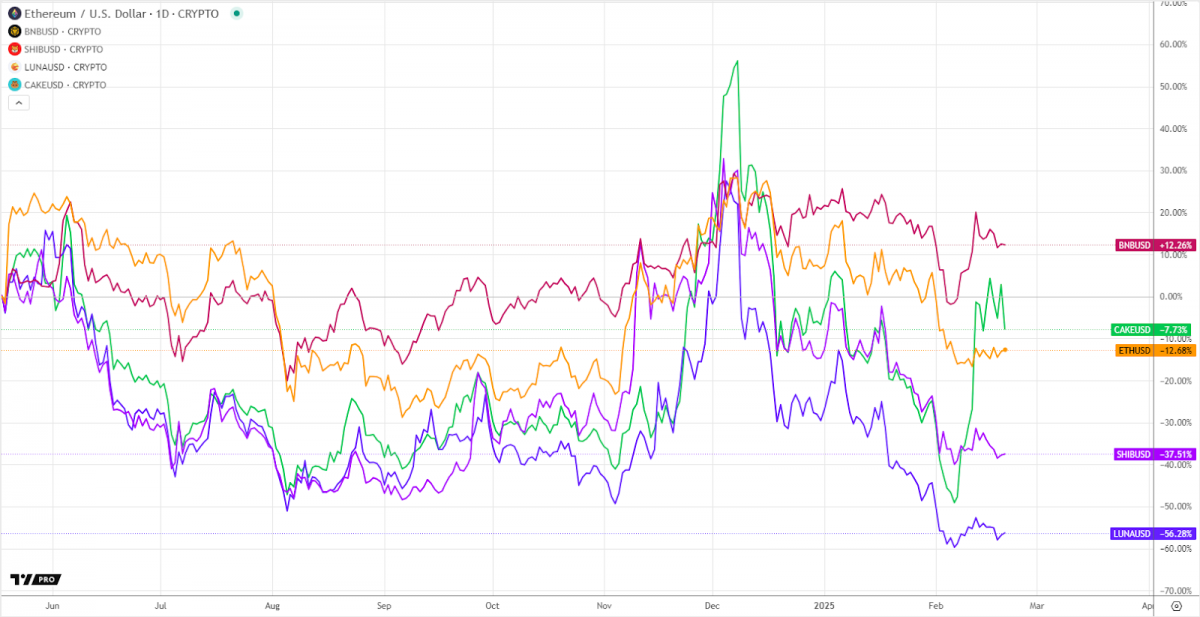Burning cryptocurrencies refers to intentionally removing coins from circulation, which is an essential tool in the economic models of blockchain projects. This mechanism helps to control inflation, boosts the value of the remaining tokens, and fulfills smart contract terms. It is important for cryptocurrency traders to understand how these processes work and their impact on the community and the market.
Additionally, price stability plays a key role in investor confidence. For instance, Ripple (XRP), which operates differently from traditional proof-of-stake or proof-of-work blockchains, does not rely on burning as a primary mechanism to control supply. Instead, Ripple price movements are influenced by regulatory developments, adoption by financial institutions, and overall market sentiment.
1. Binance and the Quarterly BNB Burn
Binance Coin (BNB) is the native token of the Binance exchange. Initially released on the Ethereum blockchain, it later migrated to Binance’s own Binance Chain blockchain. BNB is burned quarterly, with the amount burned being based on the exchange’s profits. The higher Binance’s profits, the more tokens are burned, which is aimed at reducing the overall supply of BNB, and theoretically increasing its value.
BNB operates on Binance Chain, which uses the Proof-of-Stake Authority algorithm. This gives Binance significant control over the network, making it easier to manage the burning process.
The community supported this mechanism, viewing it as an example of Binance’s transparency and long-term commitment to the ecosystem’s development. Burning BNB has also strengthened investor confidence in the token.
Factors such as increased competition from other exchanges and declining profits due to regulatory challenges are the main factors for burning, which serves as a vital element in supporting the token’s value.
2. Burning of SHIB Initiated by Vitalik Buterin
In 2021, Vitalik Buterin received 50% of all Shiba Inu (SHIB) tokens as a gift from the developers. Instead of keeping them, he burned 90% of them by sending them to an unused address to prevent SHIB from affecting the market.
SHIB runs on the Ethereum blockchain, which uses the Proof-of-Stake (PoS) algorithm after the Ethereum 2.0 update. The tokens were burned by transferring them to a “zero” address.
While the community viewed this gesture as an act of goodwill, some criticized Buterin for not giving prior notice, leading to short-term market volatility.
The enormous total supply of SHIB (quadrillions of tokens) and the low developer activity in improving the token economy are still the main reasons for burning.
However, the burning itself was a one-time act and is not part of the SHIB economy. For the project’s long-term success, it is necessary to introduce ongoing burning mechanisms into its ecosystem.
3. Burning Ethereum After Switching to Proof-of-Stake
With the introduction of EIP-1559 in 2021, Ethereum began burning some transaction fees. This became possible with the transition to PoS in 2022. Burning ETH makes it a deflationary asset, which increases its appeal to investors.
The Proof-of-Stake algorithm allows for efficient management of transaction fees and the burning process. Ethereum burns ETH automatically through smart contracts.
The Ethereum community supported this update as it reduced inflation and increased the value of ETH. However, miners, who lost income due to the switch to PoS, expressed dissatisfaction.
Such as decreased network activity (fewer transactions lead to less burning) and competition from other blockchains reduce the effectiveness of the burning mechanism.
Nevertheless, burning ETH has become an essential element of its economy, supporting the token’s value.
4. Burning Tokens of the Terra (LUNA) Project
After the collapse of the Terra ecosystem in May 2022, the developers proposed burning some of the LUNA and UST tokens to stabilize the remaining assets. However, this did not prevent the total collapse of the project.
Terra also used the Proof-of-Stake (PoS) algorithm, but the burning mechanisms were insufficient to stabilize the ecosystem. The community was disappointed, as the burning failed to restore trust in the project, and many investors lost their funds.
The lack of sufficient burning and the loss of trust after the collapse led to the coin’s complete failure. In the case of Terra, burning was the final attempt to salvage the project, but it wasn’t effective. For future projects, it’s essential to implement burning mechanisms early on.
5. Burning PancakeSwap (CAKE) Tokens
PancakeSwap, similar to Ethereum, burns CAKE tokens at the expense of a portion of the fees collected on the platform. This helps control inflation and maintain the value of the token.
PancakeSwap operates on Binance Smart Chain (BSC), which uses the Proof-of-Stake Authority algorithm. The burning process is automated through smart contracts.
The community supports this mechanism, making CAKE more attractive for long-term investments.
However, decreased platform activity and growing competition from other DEXes negatively affect the approval of burning, an essential element of its economy.

Burning cryptocurrencies is a powerful tool that can build trust in a project and serve as a last-resort strategy to prevent collapse. However, its effectiveness depends on several factors, including community trust, network activity, and competition. While burning should be preserved as part of the token economy, it is important to implement it early and make the process transparent.

Disclaimer: The views expressed in this article are those of the author and may not reflect the views of the CryptoTotem team. This article is for informational purposes only and is not intended to be used as legal, tax, investment or financial advice. The author or the publication does not hold any responsibility, directly, or indirectly, for any damage or loss caused or alleged to be caused by or connected with the use of or reliance on any content, goods or services mentioned in this article. Readers should do their own research before taking any action on this matter.

